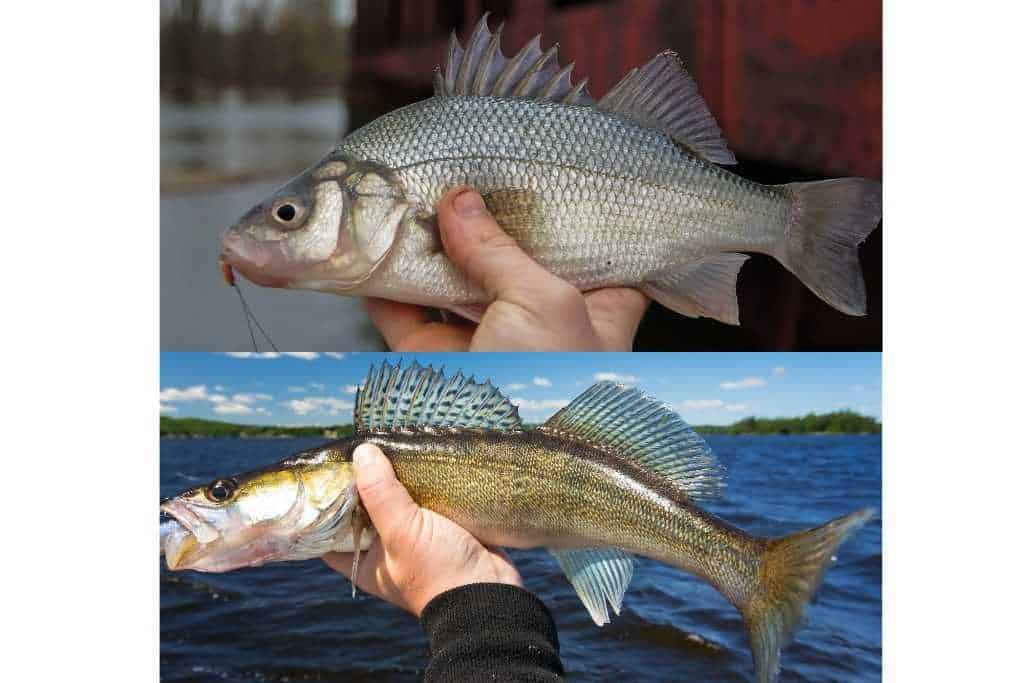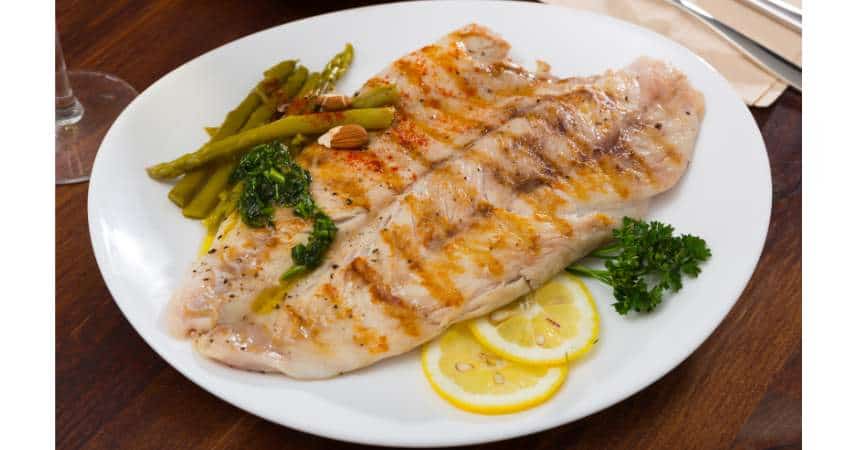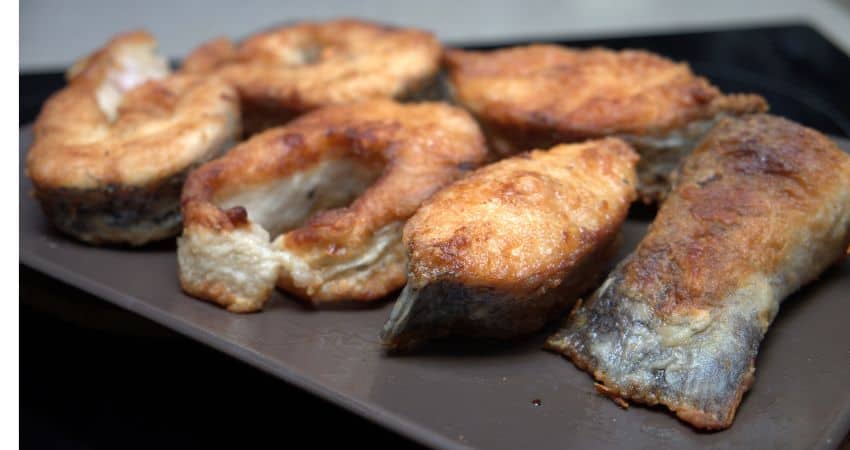Walleye vs White Perch: What’s The Difference? We Compare
Walleye and white perch share some similarities. For this reason many people ask if they’re really the same. Let’s answer, is walleye the same as white perch?
Walleye and white perch are not the same, they’re different species of fish from different families. Walleye is the S. Vitreus species and white perch is the M. americana species. Walleye grow to twice the length of the white perch and weigh approximately 20 times more.
This article will compare their tastes, textures, cooking methods, costs, mercury levels and whether one can substitute for the other in recipes. In addition, I’ll do a side-by-side comparison of their habitats, appearance and compare their nutritional value.
Walleye vs White Perch: Habitats, Size, Weight and Appearance
How can you tell the difference between the two fish?
To tell the difference between a walleye and a white perch is the body shape, size, color and body markings. Perch have a silver body with no markings, walleye have an olive green and golden color with dark bars on the upper back. Walleye average 22 inches long compared to 7-10 inches for white perch.

Other ways to tell the difference:
- Walleye have long, thin round bodies. White perch have shorter, flatter bodies.
- Perch has a dark, faint lateral line running down the body. Walleye don’t have any lateral lines.
- Walleye’s eyes are large, pearlescent and opaque. White perch have an average, dark colored eye.
Walleye and Perch Family, Scientific Classifications, Species
Walleye are from:
- Family: Percidae
- Genus: Sander
- Species: S. vitreus
- Common nicknames: Yellow pike, yellow pickerel.
White perch are from:
- Perch Family: Moronidae
- Genus: Morone
- Species: M. americana
- Common nicknames: Silver bass
Walleye Perch Habitats and North America
The following facts about the fish perch and walleye may help you while fishing and to identify the fish types.
Walleye Habitats
- Walleye are native to Canada and North America. They can be found in Canada, the Great Lakes, Hudson Bay, the Mississippi River basins from Canada, New York down south to Alabama and Arkansas.
- They can be found in lakes, reservoirs and rivers.
- They prefer large, shallow lakes and are rarely found in brackish waters.
White Perch Habitats
- Perch population are native to the Atlantic coast. They can be found from Nova Scotia down to South Carolina. They can be found in the Great Lakes.
- They can be found in brackish waters, streams, lakes, reservoirs and rivers.
- They prefer mud, silt and sandy bottom areas.
Appearance
Colors
- Perch are silver with a grayish body. The back is black or dark gray and the belly is whitish.
- Walleye have a dark, olive green back with olive green to golden sides. The coloring on the sides fades towards the white belly. There are five dark bands crossing over the back and upper sides.
Dorsal Fins
- White perch has two dorsal fins. The front dorsal has 9 spines, and the second dorsal has 8-12 soft rays.
- Walleye has two dorsal fins. The front dorsal has about 12 spines and the second dorsal has 10-13 soft rays.
Anal Fins
- Perch walleye only have soft rays on their anal fins with no spines.
Mouth
- Perch mouth doesn’t extend past the eye line. Its lower jaw slightly protrudes.
- The walleye mouth is large but doesn’t extend past the eye line. Its lower jaw protrudes and they have sharp teeth inside their mouth.
Distinguishing Marks
- White perch has a dark, faint lateral line running down the side of the body.
- Walleye has dark bars or saddles running from the upper sides over the back. Their eyes are large, pearlescent and opaque. Their caudal and anal fins have white colored tips.
Body Shape
- The perch body is flat, slightly elongated with a domed back.
- The walleye body is long, thin and round.
Size and Weight
- Perch averages 7-10 inches long and weighs between eight ounces to one pound.
- Walleye are slightly bigger on average and average 22 inches long and weigh up to 20 pounds.
Lifespan
- Perch lives up to 17 years.
- Walleye lives up to 10 years.
Diet
White perch consumes the following:
- Fish eggs
- Small minnows
- Grass shrimp
- Bloodworms
- Razor clams
Walleye consume the following:
- Insects
- Worms
- Small fish
- Yellow perch
- Minnows
- Frogs
- Crayfish
- Large invertebrates
Tastes and Textures
One of the most important things people takes into consideration when choosing a fish is its taste. When comparing the two fish, let’s examine their tastes.
Walleye tastes very similar to perch. They have a similar mild to sweet taste. At times both fish may have a slight fishy flavor depending where the fish was caught. They have a firm texture which is smooth and flakey.
For some people walleye may have a slightly fishy flavor but it’s not overpowering. The texture is firm but delicate and flakey.
Perch has a mild to sweet taste. The texture is moist, firm and flaky. They can taste somewhat fishy depending which waters they were caught.
To conduct some original research, I polled my clients, readers and members of food groups I belong to. I asked does walleye taste better?
- 54% preferred the taste of perch.
- 33% preferred the taste of walleye.
- 13% said they had no preference.
To conduct more research, I conducted a blind taste test at home. Both fish were cooked exactly the same way. 75% of the people in my test chose perch white.
Many people want to know if there’s a difference between perch and white crappie. Find out in my article, Are They The Same? We Compare.

Substitutions
When preparing recipes for dinner it’s not always possible to locate the type of fish called for. If you have some perch, you may ask, can I substitute perch for walleye?
White perch and walleye can substitute for each other due to their similar mild to sweet tastes and firm textures. Whole walleye fillets are larger than perch. More perch fillets will be required to equal the weight called for in the recipe.
Other walleye substitutes include the following:
- Yellow perch
- Snapper
- Grouper
- Tilapia
- Catfish
- Halibut
The best perch substitutes are:
- Tilapia
- Crappie
- Bluegill
- Snapper
- Sole fillets
- Lake trout
- Branding
When substituting walleye perch, always stick to the following:
- Same size and weight.
- Stick with similar fillets, whole fillet or cross section.
- Stick with skinless or skin when the recipe calls for one.
- Texture is more important for certain cooking methods. Like using a firmer texture when grilling1.
Many people consider perch a problem. Find out why and the answer in my article Comparing it to White Bass
Another popular white fish, cod, was compared to perch in my comparison article here.
Cost
The costs for fresh fish will vary depending on how the fish are caught and where they are sold. When purchasing any fish, be sure to check the label to see if it is wild-caught or farm raised. Therefore, which is costs more?
Walleye cost more per pound than white perch. The average cost for fresh walleye fillets is $20.42 per pound. The average costs for fresh perch fillet is $11.99 per pound.
To conduct some original research, I searched and checked the prices of both fish at various different stores.
I checked online at Walleye Direct and found the following prices:
- Wild, walleye fillets
- $19.80 per pound
I checked Whyte’s Fishery online and found the following prices:
- Fresh white perch
- $9.00 per pound
- fresh walleye fillets
- $17.50 per pound
I checked Doorganics online and found the following:
- Wild perch fillet
- $14.99 per pound
- Wild walleye fillets
- $23.98 per pound

Mercury Levels
The EPA and The Food and Drug Administration have issued warnings and suggestions regarding mercury levels in fish and how often they should be consumed2. This is especially important for the following:
- Pregnant women
- Developing children
- Young infants
They established a list of the following:
- Best fish
- Good choices
- Fish to avoid
Therefore, white perch vs walleye, which one has more mercury?
Walleye and white perch have similar levels of mercury. White perch and walleye are listed on the FDA’s best choice of fish regarding mercury levels.
If you’re pregnant, breast feeding or has a young child, Always check with a physician prior to eating new foods or changing your dietary habits.
Mercury warnings can change over time or affect only a particular area or state. Please check with your local EPA and FDA for the current recommendations3.
Nutrition Comparison
Below is a nutrient comparison per four ounces:
| Nutrient | Walleye (4 ounces) | White Perch (4 Ounces) |
| Calories | 105 | 134 |
| Total Fat | 1.4 g | 5.3 g |
| Saturated Fat | 0.3 g | 1.3 g |
| Protein | 22 g | 21 g |
| Cholesterol | 98 mg | 107 mg |
| Sodium | 58 mg | 46 mg |
| Potassium | 441 mg | 346 mg |
| Iron | 1.5 mg | 0.4 mg |
| Calcium | 125 mg | 27.22 mg |
Both fish contain a good number of minerals and vitamins. Keep reading below to find out how the nutrients provided benefit health.
The other day while shopping, walleye fillets were available so I bought them over perch for the added nutrients. I fried them in a pan with mixed vegetables and a side salad.
Health Benefits
Omega 3 Fatty Acids
The omega-3 fatty acids provided help keep arteries healthy and are considered heart healthy. The omega-3s may help with the following:
- Lowering triglycerides.
- Reduce inflammation.
- Reduce plaque buildup.
- Keeping bad cholesterol low.
- Keeping good cholesterol high.
- Help keep the heart rhythms more normal.
DHA and EPA, two of the fatty acids, are associated with lowering blood pressure and improving the health of blood vessels ((National Center for Biotechnology: Marine Omega-3 Supplementation and Cardiovascular Disease)).
Studies suggest omega-3s boost the effectiveness of anti-inflammatory drugs. In addition, they’ve been shown to help reduce joint pain and stiffness in people with rheumatoid arthritis.
Magnesium
Magnesium helps to calm and relax the whole body including blood vessels. It has been shown to help improve sleep related problems like insomnia ((National Institutes of Health: Magnesium)).
Magnesium helps keep blood pressure levels balanced and stable. A recent study researched 22 studies and concluded magnesium supplementation decreased diastolic and systolic blood pressure6.
Magnesium helps control muscle and nerve function, blood sugar and blood pressure.
In the muscles and heart, magnesium competes with calcium to help the muscles relax after contracting. When the body is low in magnesium, calcium can over stimulate the heart muscle’s cells causing a rapid or irregular heartbeat.

B Vitamins
The B vitamins provided include the following:
- B1 (thiamin)
- B2 (riboflavin)
- B3 (niacin)
- B5
- B6
- B9 (folate)
- B12
B vitamins help support the following:
- Digestion.
- Brain function.
- Energy levels.
- Red blood cells.
- Cardiovascular disease.
- Nerve function.
Potassium
Potassium helps the body get rid of excess sodium which helps reduce fluid build-up. The result keeps systolic and diastolic blood pressure lower ((American Heart Association: How Potassium Can Help Control High Blood Pressure)).
The more potassium you consume, the more sodium your body will lose. Consuming too much sodium or not enough potassium throws off the delicate balance the kidneys need to remove the excess water7.
According to Harvard Health, a number of studies have shown a connection between low potassium levels and increased blood pressure8.
Calcium
Calcium is important for blood pressure and the heart.
Harvard Health reports calcium helps maintain blood pressure because it helps to control the relaxing and tightening of blood vessels9.
Calcium also helps the following:
- Build and maintain strong bones.
- Muscles need calcium to function properly.
- Improve nerve function.
Phosphorus
It has been shown in scientific research to help with the following:
- Promote teeth and bone strength.
- Muscle recovery after exercise.
- Muscle contraction.
- Help the body store and manage energy.
- Help the kidneys remove waste.
- Promote healthy nerve conduction.
Selenium
Selenium is a nutrient which doesn’t receive much press. I’m unsure why many don’t write about it more. Many studies10 show selenium may help to protect the following:
- Cognitive issues
- Heart disease
- Thyroid
- The immune system
In addition to informing my clients about perch and walleye, I have researched, purchased and consumed both fish for 20 years prior to, during and after writing this article.
If you have any questions about this article don’t hesitate to email us. You can find an email on our contact page.
Read Next – More Fish Articles!
Rock Bass vs Green Sunfish – Are They The Same? We Compare
Bass vs Catfish – What’s The Difference? Let’s Compare
Brown Trout vs Salmon – Are They The Same? Let’s Compare
Halibut vs Flounder – Is There A Difference? Let’s Compare
Mahi Mahi vs Halibut: What’s The Difference? Let’s Compare
- Sea Grant North Carolina: Fish Flavors and Substitutions [↩]
- FDA: Advice about Eating Fish [↩]
- National Center for Biotechnology Information: Mercury accumulation in largemouth bass (Micropterus salmoides) in a Florida lake [↩]
- Nutrition Value: White perch fillets, white perch by Turbo Ice [↩]
- Nutrition Data: Fish, raw, walleye, pike [↩]
- National Center for Biotechnology Information: Effect of magnesium supplementation on blood pressure: a meta-analysis [↩]
- National Center for Biotechnology Information: The Effect of the Sodium to Potassium Ratio on Hypertension Prevalence: A Propensity Score Matching Approach [↩]
- Harvard Health: Potassium lowers blood pressure [↩]
- Harvard Health: Key minerals to help control blood pressure [↩]
- National Institutes of Health: Selenium [↩]
